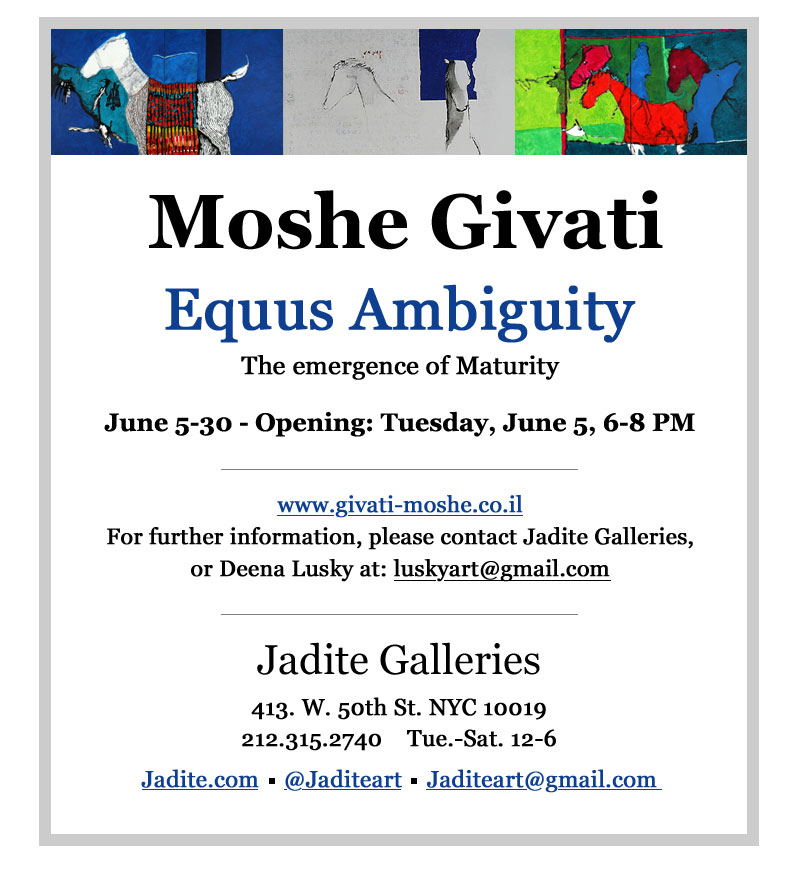| Moshe Givati
Curator: Deena Lusky
EQUUS introduced to Broadway in 1974 a quality of thoughtfulness that was rare in the contemporary theatre of that time. The play ran on Broadway for 3 years, receiving a Tony Award for best play in 1975, and was later transformed into a blockbuster film still studied today. Israeli artist Moshe Givati saw the play on Broadway in 1977; it had a cathartic impact on him. For decades, the bold, disturbing concepts it raised continued to jolt and stir him. EQUUS AMBIGUITY is the end result of that artistic interpretation of Peter Shaffer’s play, which took Givati close to three decades later to seriously touch this concept fully.
Equus focuses on the causes underlying a seemingly senseless act of violence by an adolescent boy, an act that forces the characters to confront questions of responsibility and ultimate meaning. Through his characters, Shaffer explores the dilemmas of late-twentieth-century existence in England and, by extension, in the entire industrialized world. His discussion broaches the conflict between Apollonian and Dionysian values and systems in human life. In an increasingly commercial and mechanized culture, is there any place for human endowments such as ecstasy and worship? Is our trust in science as foolish—even more foolish—than the pagans' belief in their gods? Does being "normal" in such a culture entail losing one's individuality and learning to live without passion?
Givati, who ironically passed away in April 2012, just two months prior to this exhibition in Manhattan, struggled throughout his artistic career with that same dilemma. His repeated attempts without success to blend into the Israeli art scene of the 60’s and 70’s and conform to the general expectations of an aspiring artist, caused him deep personal anguish, dissociating himself entirely, for a period of 20 years, until his recent death at the age of 78.
In his Equus series of paintings, Givati expresses the lifelong dilemma of searching for the source of his creativity while desperately seeking the equilibrium needed to survive in this world. His manic-depressive nature fed on a desire to reach perfection, manifested in both his brilliance and ingenuity, positioning him as idiosyncratic in the eyes of art critics who claimed that his work cannot be defined in a clear-cut way.
As Givati himself expressed to me a short while before he died, “I am constantly intimidated by the empty canvas in front of me. I have no delineated technique per se, I don’t paint using a palette, and I never plan the subject for my paintings. Rather, I dip the brush into a can of color onto the canvas, and let the story contained present itself to me. I let the canvas shape and express what intuitively words cannot do, helping me to define the fervent intricacies that rise to the surface.” Givati’s entire collection of paintings, the Equus series included, are untitled. According to Givati, his paintings are a tool used by the viewer to define what they see, and any concept the viewer discovers is their own privilege to explore.
In his Equus series of paintings, Givati stressed time and again that he did not have any fascination with horses and in fact, according to him, he did not paint horses in his Equus series. This statement is somewhat similar in context to René Magritte’s “The Betrayal of Images.” To amplify his statement, he painted two horses with a whitish background, inscribed with Hebrew writing, “This is not a painting of a horse’s head.”
Givati conveys certain violence in some of his Equus paintings, somewhat like Pablo Picasso’s referral to the tragedies and suffering of war in “Guernica.” Givati speaks of the torture and suffering on a personal level, as he continuously searched for equilibrium deep within himself.
There is the question that, unfortunately, cannot be answered by Givati himself, regarding his constant use of two identically sized canvases in creating a painting that is not defined purely as Diptych. The images he painted on one canvas are incomplete without the other, and only together present a harmonious composition of coloring, expressionistic images and use of a grid. Nevertheless, a partition does exist. As Givati mentioned to me once: “The viewer has a choice; he may dislike what he sees and moves on, or feel something that resonates deep within him, and never leave.” 
|